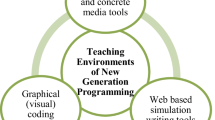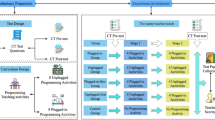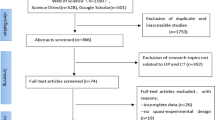Abstract
Different instructional strategies have been drawn to assist elementary school students in improving computational thinking (CT) skills and student engagement (SE) in unplugged programming activities. This paper aimed to explore how the interactive strategies of unplugged programming affect CT skills and SE. The study was conducted based on a quasi-experimental research method. The sample was composed of 104 sixth-grade students from northern China. The students in the experimental group learned with interactive unplugged programming, whereas those in the control group learned with non-interactive unplugged programming. Analysis of Covariance statistics and Partial Least Squares Structural Equation Modeling were adopted for data analysis. Results showed that the performance of the experimental group in CT skills and SE was considerably better than that of the control group. Moreover, the predictive relationships were more complex between CT skills and SE in the experimental group. In general, these findings confirmed the teaching value of interactive unplugged programming, and further emphasized the important role of students’ CT skills in programming engagement. Therefore, through the application of interaction in instruction design, each student can be assigned a positive role to create a programming classroom that is more conducive to students.





Similar content being viewed by others
Data availability
The datasets used and/or analysed during the current study are available from the corresponding author on reasonable request.
References
Angeli, C., Voogt, J., Fluck, A., Webb, M., Cox, M., Malyn-Smith, J., & Zagami, J. (2016). A K-6 computational thinking curriculum framework: Implications for teacher knowledge. Educational Technology & Society, 19(3), 47–57. http://www.jstor.org/stable/jeductechsoci.19.3.47.
Aranda, G., & Ferguson, J. P. (2018). Unplugged programming: The future of teaching computational thinking? Pedagogika, 68(3), 279–292. https://doi.org/10.14712/23362189.2018.859.
Aronson, E. (2002). Building empathy, compassion, and achievement in the jigsaw classroom. Educational Psychology, 10, 209–225. https://doi.org/10.1016/B978-012064455-1/50013-0
Bell, T., & Vahrenhold, J. (2018). CS unplugged-how is it used, and does it work? Springer.
Bond, T. G., & Fox, C. M. (2015). Applying the Rasch model: Fundamental measurement in the human sciences (3rd ed.). Routledge.
Brackmann, C. P., Román-González, M., Robles, G., Moreno-León, J., Casali, A., & Barone, D. (2017). Development of computational thinking skills through unplugged activities in primary school. Proceedings of the 12th Workshop on Primary and Secondary Computing Education, Netherlands (pp. 65-72). Nijmegen: ACM. https://doi.org/10.1145/3137065.3137069
Chalmers, C. (2018). Robotics and computational thinking in primary school. International Journal of Child-Computer Interaction, 17, 93–100. https://doi.org/10.1016/j.ijcci.2018.06.005
Chen, G., Shen, J., Barth-Cohen, L., Jiang, S., Huang, X., & Eltoukhy, M. (2017). Assessing elementary students’ computational thinking in everyday reasoning and robotics programming. Computers & Education, 109, 162–175. https://doi.org/10.1016/j.compedu.2017.03.001
Chen, J., Wang, M., Kirschner, P. A., & Tsai, C.-C. (2018). The role of collaboration, computer use, learning environments, and supporting strategies in CSCL: A meta-analysis. Review of Educational Research, 88(6), 799–843. https://doi.org/10.3102/0034654318791584
Chi, M. T. H. (2009). Active-constructive-interactive: A conceptual framework for differentiating learning activities. Topics in Cognitive Science, 1, 73–105. https://doi.org/10.1111/j.1756-8765.2008.01005.x
Chi, M. T. H., Kang, S., & Yaghmourian, D. L. (2017). Why students learn more from dialogue- than monologue-videos: Analyses of peer interactions. Journal of the Learning Sciences, 26(1), 10–50. https://doi.org/10.1080/10508406.2016.1204546
Chi, M. T. H., & Wylie, R. (2014). The ICAP framework: Linking cognitive engagement to active learning outcomes. Educational Psychologist, 49, 219–243. https://doi.org/10.1080/00461520.2014.965823
Chin, W. (1998). Issues and opinion on structural equation modeling. MIS Quarterly, 22(1), 7–16.
Chin, W. W., Marcolin, B. L., & Newsted, P. R. (2003). A partial least squares latent variable modeling approach for measuring interaction effects: Results from a Monte Carlo simulation study and an electronic-mail emotion/adoption study. Information Systems Research, 14(2), 189–217. https://doi.org/10.1287/isre.14.2.189.16018
Chong, J., & Hurlbutt, T. (2007). The social dynamics of pair programming. In Proceedings of the 29th international conference on software engineering (ICSE’07) (pp. 354–363). Minneapolis: IEEE. https://doi.org/10.1109/ICSE.2007.87
Conde, M. Á., Fernández-Llamas, C., Rodríguez-Sedano, F. J., Guerrero-Higueras, Á. M., & García-Peñalvo, F. J. (2017). Promoting computational thinking in K-12 students by applying unplugged methods and robotics. In Proceedings of the 5th International Conference on Technological Ecosystems for Enhancing Multiculturality (pp. 1-6). Cádiz: ACM. https://doi.org/10.1145/3144826.3145355
de Araujo, A. L. S. O., Andrade, W. L., & Serey Guerrero, D. D. (2016). A systematic mapping study on assessing computational thinking abilities. In Proceedings of the 2016 IEEE Frontiers in Education Conference (FIE) (pp. 1–9). Erie: IEEE. https://doi.org/10.1109/FIE.2016.7757678
Dunleavy, M., Dede, C., & Mitchell, R. (2009). Affordances and limitations of immersive participatory augmented reality simulations for teaching and learning. Journal of Science Education and Technology, 18(1), 7–22. https://doi.org/10.1007/s10956-008-9119-1
Durak, H. Y. (2020). The effects of using different tools in programming teaching of secondary school students on engagement, computational thinking and reflective thinking skills for problem solving. Technology, Knowledge and Learning, 25(1), 179–195. https://doi.org/10.1007/s10758-018-9391-y
Durak, H. Y., & Güyer, T. (2018). Design and development of an instructional program for teaching programming processes to gifted students using Scratch. In Curriculum development for gifted education programs (pp. 61–99). Hershey: IGI Global.
Evans, T., Kensington-Miller, B., & Novak, J. (2021). Effectiveness, efficiency, engagement: Mapping the impact of pre-lecture quizzes on educational exchange. Australasian Journal of Educational Technology, 37(1), 163–177. https://doi.org/10.14742/ajet.6258.
Fredricks, J., Blumenfeld, P., Friedel, J., & Paris, A. (2005). School engagement. What do children need to flourish? Conceptualizing and measuring indicators of positive development (pp. 305-321). New York, NY: Springer. https://doi.org/10.1007/0-387-23823-9_19
Fredricks, J. A., Filsecker, M., & Lawson, M. A. (2016). SE, context, and adjustment: Addressing definitional, measurement, and methodological issues. Learning & Instruction, 43, 1–4. https://doi.org/10.1016/j.learninstruc.2016.02.002
Gao, X., & Hew, K. F. (2021). Toward a 5E-based flipped classroom model for teaching computational thinking in elementary school: Effects on student computational thinking and problem-solving performance. Journal of Educational Computing Research, 59, 1–32. https://doi.org/10.1177/07356331211037757
Grover, S., & Pea, R. (2018). Computational thinking: A competency whose time has come. Computer science education: Perspectives on teaching and learning in school (pp. 19–37). Bloomsbury Academic.
Hair, J. F., Ringle, C. M., & Sarstedt, M. (2011). PLS-SEM: Indeed a silver bullet. Journal of Marketing Theory and Practice, 19(2), 139–152. https://doi.org/10.2753/MTP1069-6679190202
Henderson, B. (2019). Beyond “active” learning: how the ICAP framework permits more acute examination of the popular peer instruction pedagogy. Harvard Educational Review, 89(4), 611–635. https://doi.org/10.17763/1943-5045-89.4.611.
Highfield, K. (2010). Robotic toys as a catalyst for mathematical problem solving. Australian Primary Athematic Classroom, 15(2), 22–27. https://doi.org/10.3316/INFORMIT.150648554236567
Howell, D. C. (2002). Statistical methods for psychology (5th ed.). Duxbury.
Kafai, Y. B., & Vasudevan, V. (2015). Constructionist gaming beyond the screen: middle school students’ crafting and computing of touchpads, board games, and controllers. In Proceedings of the Workshop in Primary and Secondary Computing Education (WiPSCE ’15) (pp. 49-54). London, UK: ACM. https://doi.org/10.1145/2818314.2818334
Kotsopoulos, D., Floyd, L., Khan, S., Namukasa, I. K., Somanath, S., Weber, J., et al. (2017). A pedagogical framework for computational thinking. Digital Experiences in Mathematics Education, 3(2), 154–171. https://doi.org/10.1007/s40751-017-0031-2
Kuo, W. C., & Hsu, T. C. (2020). Learning computational thinking without a computer: How computational participation happens in a computational thinking board game. Asia-Pacific Education Research, 29(1), 67–83. https://doi.org/10.1007/s40299-019-00479-9
Lambert, L., & Guiffre, H. (2009). Computer science outreach in an elementary school. Journal of Computing Sciences in Colleges, 24(3), 118–124. https://doi.org/10.5555/1409873.1409896
Law, K. M., Lee, V. C., & Yu, Y. T. (2010). Learning motivation in e-learning facilitated computer programming courses. Computers & Education, 55(1), 218–228. https://doi.org/10.1016/j.compedu.2010.01.007
Lee, S.W.-Y., Shih, M., Liang, J.-C., & Tseng, Y.-C. (2021). Investigating learners’ engagement and science learning outcomes in different designs of participatory simulated games. British Journal of Educational Technology, 52(3), 1197–1214. https://doi.org/10.1111/bjet.13067
Lindberg, R. S. N., Laine, T. H., & Haaranen, L. (2019). Gamifying programming education in K-12: A review of programming curricula in seven countries and programming games. British Journal of Educational Technology, 50(4), 1979–1995. https://doi.org/10.1111/bjet.12685
Lin, H.-M., Lee, M.-H., Liang, J.-C., Chang, H.-Y., Huang, P., & Tsai, C.-C. (2020). A review of using partial least square structural equation modeling in e-learning research. British Journal of Educational Technology, 51(4), 1354–1372. https://doi.org/10.1111/bjet.12890
Looi, C. K., How, M. L., Wu, L. K., Seow, P., & Liu, L. (2018). Analysis of linkages between an unplugged activity and the development of computational thinking. Computer Science Education, 28(3), 255–279. https://doi.org/10.1080/08993408.2018.1533297
Mladenović, M., Boljat, I., & Žanko, Ž. (2018). Comparing loops misconceptions in block-based and text-based programming languages at the K-12 level. Education and Information Technologies, 23(4), 1483–1500. https://doi.org/10.1007/s10639-017-9673-3
Munns, G., & Woodward, H. (2006). SE and student self-assessment: The real framework. Assessment in Education Principles Policy & Practice, 13(2), 193–213. https://doi.org/10.1080/09695940600703969
Nagy, J. (2018). Evaluation of online video usage and learning satisfaction: an extension of the technology acceptance model. International Review of Research in Open and Distributed Learning, 19(1), 160–185. https://doi.org/10.19173/irrodl.v19i1.2886.
Papadakis, S., Kalogiannakis, M., & Zaranis, N. (2016). Developing fundamental programming concepts and computational thinking with ScratchJr in preschool education: A case study. International Journal of Mobile Learning and Organisation, 10(3), 187–202. https://doi.org/10.1504/IJMLO.2016.077867
Papert, S., & Harel, I. (1991). Situating constructionism. In: S. Papert & I. Harel (Eds.), Constructionism (chap.1). Ablex Publishing Corporation.
Robins, A., Rountree, J., & Rountree, N. (2003). Learning and teaching programming: A review and discussion. Computer Science Education, 13(2), 137–172. https://doi.org/10.1076/csed.13.2.137.14200
Rodriguez, B., Rader, C., & Camp, T. (2016). Using student performance to assess CS unplugged activities in a classroom environment. Proceedings of the 2016 ACM Conference on Innovation and Technology in Computer Science Education (ITiCSE ’16), Arequipa, Peru, 95-100. ACM. https://doi.org/10.1145/2899415.2899465
Saxena, A., Lo, C. K., Hew, K. F., & Wong, G. K. W. (2019). Designing unplugged and plugged activities to cultivate computational thinking: An exploratory study in early childhood education. Asia Pacific Education Researcher, 29, 55–66. https://doi.org/10.1007/s40299-019-00478-w
Selby, C. C. (2014). How can the teaching of programming be used to enhance computational thinking skills? University of Southampton.
Sharma, K., Papavlasopoulou, S., & Giannakos, M. (2019). Coding games and robots to enhance computational thinking: How collaboration and engagement moderate children’s attitudes? International Journal of Child-Computer Interaction, 21, 65–76. https://doi.org/10.1016/j.ijcci.2019.04.004
Shigen, S., & Yugo, H. (2020). Prompting learnerlearner collaborative learning for deeper interaction: Conversational analysis based on the ICAP framework. Proceedings of the 28th International Conference on Computers in Education (pp. 1-6). Taiwan: Asia- Pacific Society for Computers in Education. Retrieved from https://apsce.net/icce/icce2020/proceedings/paper_156.pdf
Shirouzu, H., Miyake, N., & Masukawa, H. (2002). Cognitively active externalization for situated reflection. Cognitive Science, 28(4), 469–501. https://doi.org/10.1207/s15516709cog2604_3
Sun L., Hu, L., Zhou, D., & Yang, W. (2022). Evaluation and developmental suggestions on undergraduates’ computational thinking: a theoretical framework guided by Marzano’s new taxonomy. Interactive Learning Environments, online, 1–23. https://doi.org/10.1080/10494820.2022.2042311.
Tsai, M.-J., Chien, F. P., Lee, S.W.-Y., Hsu, C.-Y., & Liang, J.-C. (2022). Development and validation of the Computational Thinking Test for Elementary School Students (CTT-ES): Correlate CT competency with CT disposition. Journal of Educational Computing Research, 60(5), 1–20. https://doi.org/10.1177/07356331211051043
Tsarava, K., Moeller, K., Pinkwart, N., Butz, M., Trautwein, U., & Ninaus, M. (2017). Training computational thinking: game-based unplugged and plugged-in activities in primary school. In Proceedings 11th European Conference on Game-Based Learning ECGBL 2017 (pp. 687-695). Graz, Austria: Academic Conferences International Limited. Retrieved from https://www.researchgate.net/publication/320491120
Threekunprapa, A., & Yasri, P. (2020). Unplugged coding using flowblocks for promoting computational thinking and programming among secondary school students. International Journal of Instruction, 13(3), 207–222. https://doi.org/10.29333/iji.2020.13314a.
Wang, F. H. (2017). An exploration of online behaviour engagement and achievement in flipped classroom supported by learning management system. Computers & Education, 114, 79–91.
Wiggins, B. L., Eddy, S. L., Grunspan, D. Z., & Crowe, A. J. (2017). The ICAP active learning framework predicts the learning gains observed in intensely active classroom experiences. AERA Open, 3(2), 1–14. https://doi.org/10.1177/2332858417708567
Wing, J. M. (2011). Research notebook: Computational thinking—what and why. The Link Magazine. Computer Science. Retrieved from https://www.cs.cmu.edu/link/research-notebook-computational-thinking-what-and-why. Accessed 10 Feb 2021.
Yee, E. (2019). Abstraction and concepts: When, how, where, what and why? Language, Cognition and Neuroscience, 34(10), 1257–1265. https://doi.org/10.1080/23273798.2019.1660797
Zhang, J.-H., Meng, B., Zou, L.-C., Zhu, Y., & Hwang, G.-J. (2021). Progressive flowchart development scaffolding to improve university students’ computational thinking and programming self-efficacy. Interactive Learning Environments, online, 1–18. https://doi.org/10.1080/10494820.2021.1943687.
Zhong, B., Wang, Q., & Chen, J. (2016). The impact of social factors on pair programming in a primary school. Computers in Human Behavior, 64, 423–431. https://doi.org/10.1016/j.chb.2016.07.017
Zmutlu, M., Atay, D., & Erdoan, B. (2021). Collaboration and engagement based coding training to enhance children’s computational thinking self-efficacy. Thinking Skills and Creativity, 40, 1–8. https://doi.org/10.1016/j.tsc.2021.100833
Funding
This study was also supported by the National Natural Science Foundation of China (Project Approval # 62077012).
Author information
Authors and Affiliations
Corresponding authors
Ethics declarations
Conflicts of interest
The authors have no relevant financial or non-financial interests to disclose.
The authors have no conflicts of interest to declare that are relevant to the content of this article.
All authors certify that they have no affiliations with or involvement in any organization or entity with any financial interest or non-financial interest in the subject matter or materials discussed in this manuscript.
The authors have no financial or proprietary interests in any material discussed in this article.
Ethics approval
All participants were informed the right of voluntary participation and the freedom of quitting the study.
Consent to participate
Informed consent was obtained from all individual participants included in the study.
Additional information
Publisher's note
Springer Nature remains neutral with regard to jurisdictional claims in published maps and institutional affiliations.
Appendices
Appendix 1: Examples of pre- and post-tests (translated from Chinese to English)
1.1 Pre-test
-
The map near the home community is shown in the figure. Mom needs to go to the pharmacy to buy some medicines after getting off work today by bus, buy some vegetables for dinner, go to the bank to do some things, and finally return to the community. Mom can choose to get off at bus stop A, B, or C. In addition, gate A or B can be used to enter the community. Considering the distance, please choose a suitable route for mom.

1.2 Post-test
-
The map near the home community is shown in the figure. On Sunday, Cindy plans to go out of the community. She needs to go to the drugstore and the supermarket to buy something, then go to the bank to do some things, and finally take the bus to date with friends. The bus stops have three stops, A, B, and C, and the community gate has A or B for entry or exit. Considering the distance, please choose a suitable route for Cindy.

Appendix 2: Example of coding metric: item 3 in the pre-test
Tables
Appendix 3: The results of confirmatory factor analysis
As shown in Table
4, the factor loadings, Cronbach’s alpha, composite reliability (CR) and average variance extracted (AVE) values (Hair et al., 2011) were adopted to evaluate the two PLS measurement models. Chin (1998) has contended, when there were other items in the construct, item factor loadings with 0.5 or 0.6 were considered to be suitable. Hence, the factor loadings were adequate for the items in the variables. In terms of the internal consistency and construct reliability, the CR values of each variable exceeded the minimum value of 0.7, and the AVE values of construct were larger than 0.5. Table
5 shows the correlation matrix and the square root of the AVE value of SE and CT variables. The results suggested that the square root of the AVE value for each variable was larger than the correlation coefficients between the variable and the others for both groups. Hence, the verification of the model thus confirmed the convergent and construct validity of the variables in this model.
Rights and permissions
Springer Nature or its licensor (e.g. a society or other partner) holds exclusive rights to this article under a publishing agreement with the author(s) or other rightsholder(s); author self-archiving of the accepted manuscript version of this article is solely governed by the terms of such publishing agreement and applicable law.
About this article
Cite this article
Li, Q., Jiang, Q., Liang, JC. et al. Effects of interactive unplugged programming activities on computational thinking skills and student engagement in elementary education. Educ Inf Technol 28, 12293–12318 (2023). https://doi.org/10.1007/s10639-023-11634-7
Received:
Accepted:
Published:
Issue Date:
DOI: https://doi.org/10.1007/s10639-023-11634-7




